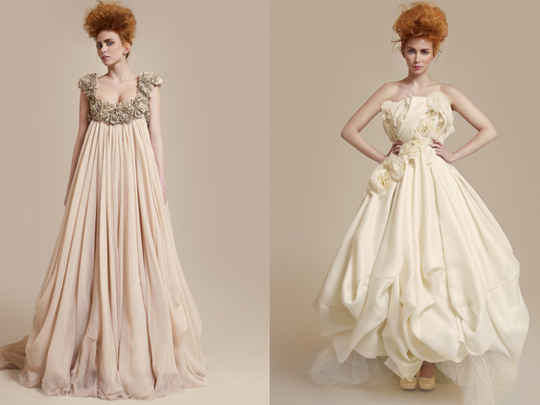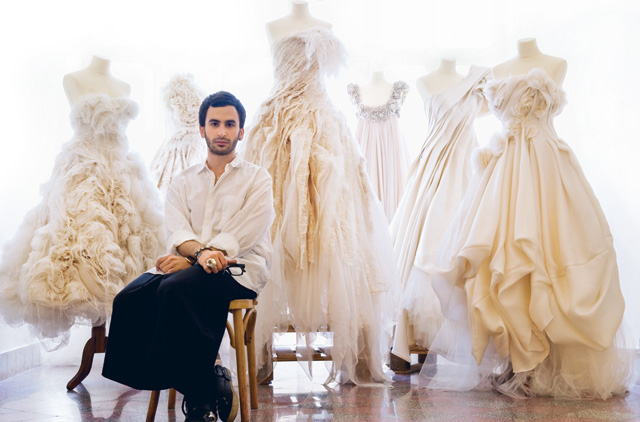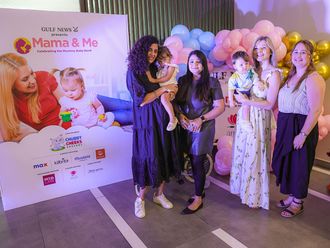
No red carpet event is complete these days without a celebrity or two squeezed into one of their creations.
But while Lebanese designers have become the byword for glamour, don't be fooled into thinking that Beirut style is only about bling.
Not far from the plush showrooms selling extravagant ball gowns is a growing fashion scene where edge and individuality are king and designers are making up their own rules.
This is the new generation of Lebanese fashion designers, whose creations have not yet reached the international red carpet but are rapidly gaining favour amongst local fashionistas.
Some of these newcomers took part in the Fashion Daze event in mid-September in Beirut. This first-of-its-kind event was a showcase of talent where local young designers were teamed up with others from abroad and given a space to interpret Beirut through their work, aided by a photographer. Although the event doesn't fully sum up the emerging fashion scene, a look through the exhibition is enough to notice a remarkable change in the way fashion is perceived by the young generation of designers — a change welcomed by fashion experts in the country.
Amine Jreissati, a stylist and head of the fashion department at Marie Claire Arabia, Gala and Layalina magazines, is keen on the emerging talent and says he is doing his "best to support these new designers" by featuring their work in local fashion pages.
Comparing them to their older compatriots, famous for their shiny couture pieces, Jreissati sees that the new generation is certainly more promising. "Big names usually do the same stuff and they tend to repeat themselves. The new generation, on the contrary, keeps the same style — their unique identity — but in a new way. They are trying to be a bit different and this is very good because we need innovation and new spirit."
Jreissati explains: "While older designers mostly do couture, the new generation is trying to combine couture and ready-to-wear, which was started by [designer] Rabih Kayrouz in what he calls ‘Nouvelle Couture' [the new couture]."
Supporting new talent
Kayrouz' support to young designers has been evident through the initiative Starch, which he launched two years ago to support new talents by showcasing their creations and selling them through the Starch boutique in downtown Beirut.
One such talent is Krikor Jabotian. The 24-year-old launched his career through Starch and is now leading the pack, having opened his own showroom in Beirut last year.
Although having briefly interned at Elie Saab, Jabotian does not wish to aim his creations at celebrities who walk the red carpet. "I am more into the nouvelle couture sector, a different way of perceiving couture far from bling, mermaid or Cinderella-like dresses," he tells tabloid! during an interview in his studio.
"I try not to be a trend slave but create my own mood, ambiance and line which I have drawn and will keep drawing for years to come."
Beauty to Jabotian comes in the raw idea, unlike the refined result for which glamour queens the world over turn to Lebanese designers like Saab, Georges Chakra and Zuhair Murad. Take a close look at Jabotian's creations, and you'll notice that almost all the hems are left unfinished. Even a wedding dress in his latest collection, the poetic Au gré d'un brise (the liking of a breeze) is entirely made out of fabric leftovers.
"I'm spontaneous and intuitive in creating my designs. I like them rough," he says, reminding me in French that "c'est dans l'imperfection que reside tout le charme" (charm lies in the imperfection).
What is most important for the young designer is to be true to himself as an artist regardless of commercial expansion and success. "My work is addressed to a small elite of people who like my style and respect it. I am working slowly but surely, and I refuse to compromise or change my identity for commercial reasons or grow for the sake of growth."
Another designer looking to eschew what's expected of Lebanese designers is Sandra Mansour. Like Jabotian, Mansour also interned with Saab, but the 26-year-old is concentrating on ready-to-wear rather than couture. "Elie Saab is one of the greats to me and I learned so much working with him. His technique and sensibility are truly inspirational," says Mansour.
"However, I am more into creating a ready-to-wear line which can be worn everyday. When working on my collections, I stress simplicity and a more modern feel, keeping in mind that less is more.
‘Ballerina at sunrise'
"My approach is discreet, less about the glamour, yet still maintaining a certain distinguishable elegance."
Mansour's latest collection consists of elegant yet colourful cocktail dresses and separates which are meant to echo "a ballerina dancing at sunrise". The lines are clean yet little details and vibrant colours add a playful touch to her creations.
Born and brought up in Geneva, the designer moved to Beirut to kick-start her career in fashion, citing the city's chaotic and diverse nature as her main inspiration. She is aware of the new wave sweeping the country and feels lucky to be part of it, saying young Lebanese seem to be developing a new attitude to fashion.
"I think people have changed and they want something different, especially the younger crowd. They have realised that it is harder to be dressed in a simpler and understated manner rather than to be overdressed. I think the ‘bling' fad is out."
Jabotian and Mansour are not the only designers taking part in Beirut's new fashion wave. Worth checking out are London-based Karen Karam, whose popular ready-to-wear collection is stocked in the fashion outlet Boutique 1 in Dubai, and Ronald Abdala, whose creations are finding success through the online fashion outlet dia-boutique.com. Then there's Lara Khoury, who started her own brand, Ilk prêt-a-couture, in 2008, and Hassan Idriss, whose label Hass Driss was launched at London Fashion Week in 2009.
Despite their differing backgrounds, there's something that unites many of the new wave designers beyond their rejection of ostentation: the majority are recent graduates of a Lebanese fashion school, ESMOD-Beirut.
Missak Hajiavedikian, Georges Azzi, Assaad Al-Osta, Rami Kadi and Jabotian are a few names that Sako Sahagian, a professor at the school, mentions when asked to list a few of his talented students who are taking part in the emerging local fashion scene.
"I think there is a new generation of very talented young designers in Lebanon," he says. "What makes them different from the generation before is that they do more research and they are more up-to-date and growing faster than others."
Art and fashion
Although similarly trained, these designers have taken very different directions and inspirations for their respective brands. As a Lebanese-Armenian, Hajiavedikian, for example, takes most of his inspiration from his Armenian heritage. For his launch collection in 2008, entitled Gorky, The Artist and his Mother, the designer used prints of the Armenian-born artist Archille Gorky's most famous painting on dresses and handbags, turning them into objects of art and fashion at the same time.
When asked what he thought about the quick success and popularity of this generation of designers, Sahagian believes that apart from their evident talents, the media has also been a great help for these newcomers.
For his part, the stylist Jreissati likes to use young local designers to add local flavour to magazines. However, he only chooses to features those with distinctive "direction and style" in their work. "The most important thing for designers is to have their identity and their own image and this is what some of the young generation of designers, like Krikor and Khoury, are doing, which is why I tend to use their creations."
But despite exposing these new designers to the public through fashion magazines, Jreissati still believes that the general public is not as supportive to these talents as they should be.
"People are not obsessed by big names, but unfortunately they tend to go to big names because they don't believe that the new designers are as good or talented as the big ones. And this is our job as media to promote these young designers and show people what's happening around and to introduce these new amazing talents which deserve to be known and reachable by the public."
Competition vs collaboration
The designers of the Lebanese new wave may have worked their way up from the fiercely competitive fashion schools and internships at Elie Saab, but when it comes to business, they believe in strength in numbers — and in collaborating with each other.
The Azzi-Osta collaboration between designers Georges Azzi and Assaad Osta started as an idea between the two back when they were students at ESMOD-Beirut. Later, both interned at Elie Saab for 16 months and as a result developed "a way of work, a criteria and a rhythm", which made it practical for them to work together.
"Competition is part of the game in fashion — it's the driver of the brand and creativity. But on the ground, it is not that important, because there is room for everybody and every taste on the market," says Osta.
About the benefits of their collaboration, Osta explains: "Communicating keeps you updated, it's always easier to receive advice from a partner than an outsider, because you know he wants the best for the brand."
What also drives these two designers to collaborate with each other and occasionally with other designers, is sometimes just "the fun of it".
"Fashion is a very serious business, you know that from the first day of school, but it's all about fun in the end. It's meant to be enjoyed," says Azzi.
Glamour is not dead
Elie Saab and Zuhair Murad are pretty much a guaranteed presence at serious red carpet events. But in the last couple of years another wave of Lebanese designers has gone for all-out glamour — with great success.
Names like Tony Ward, Ella Zahlan and Basil Soda have become a choice for Hollywood stars and musicians including P!nk, Katy Perry (below right), Paula Abdul and Mariah Carey.
Ward recently dressed Osborne for the Emmy Awards, while P!nk wore one of his creations to the Grammys last year. Carey, Whitney Houston and Ke$ha are also fans of his glamorous creations. P!nk also picked Zahlan to create the wedding dress in her music video I Don't Believe You (below).
Soda has become popular especially for his curve-hugging gowns, which have been seen on Kelly Rowland, Abdul and Perry, to name a few.









